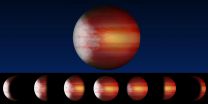(Press-News.org) TORONTO, ON -- "Cloudy for the morning, turning to clear with scorching heat in the afternoon."
While this might describe a typical late-summer day in many places on Earth, it may also apply to planets outside our solar system, according to a new study by an international team of astrophysicists from the University of Toronto, York University and Queen's University Belfast.
Using sensitive observations from the Kepler space telescope, the researchers have uncovered evidence of daily weather cycles on six extra-solar planets seen to exhibit different phases. Such phase variations occur as different portions of these planets reflect light from their stars, similar to the way our own moon cycles though different phases.
Among the findings are indications of cloudy mornings on four of them and hot, clear afternoons on two others.
"We determined the weather on these alien worlds by measuring changes as the planets circle their host stars, and identifying the day-night cycle," said Lisa Esteves, a PhD candidate in the Department of Astronomy & Astrophysics at the University of Toronto, and lead author of the study published today in The Astrophysical Journal.
"We traced each of them going through a cycle of phases in which different portions of the planet are illuminated by its star, from fully lit to completely dark," said Esteves.
Because the planets are very near to their stars, they are expected to rotate counter-clockwise - just as the majority of objects in our solar system do - with the right side moving in the direction of each planet's orbit. This causes an eastward movement of the planet's surface and therefore an eastward circulation of atmospheric winds. As a result, clouds that form on the planet's night side, where temperatures are cooler while it faces away from its host star, would be blown to the planet's morning side.
"As the winds continue to transport the clouds to the day side, they heat up and dissipate, leaving the afternoon sky cloud-free," said Esteves. "These winds also push the hot air eastward from the meridian, where it is the middle of the day, resulting in higher temperatures in the afternoon."
For four of the planets, the researchers saw excess brightness in the Kepler data that corresponds to when the morning side is visible. For the other two, they saw an excess when the evening side is visible.
"By comparing the planets' previously determined temperatures to the phase cycle measurements provided by Kepler, we found that the excess brightness on the morning side is most likely generated by reflected starlight," said Esteves. "These four planets are not hot enough to generate this excess light through thermal emission.
"The excess light seen on the two very hot planets can be explained by thermal emission," said Esteves. "A likely explanation is that on these two planets, the winds are moving heat towards the evening side, resulting in the excess brightness."
The Kepler telescope was the ideal instrument for the study of exoplanet phase variations. The very precise measurements it provided and the vast amount of data it collected allowed astronomers to measure the tiny signals from these distant worlds. Most of the planets examined in this study are very hot and large, with temperatures greater than 1600 degrees Celsius and sizes comparable to Jupiter - conditions far from hospitable to life but excellent for phase measurements.
Kepler data has been used in the past to measure the temperature of these planets, but this is the first instance in which phase variations were used to measure the morning- and evening-side specific brightnesses of a collection of planets.
"The detection of light from these planets hundreds to thousands of light years away is on its own remarkable," said study co-author Dr. Ernst de Mooij, the Michael West Fellow at the Astrophysics Research Centre from the School of Mathematics and Physics at Queen's University Belfast. "But when we consider that phase cycle variations can be up to 100,000 times fainter than the host star, these detections become truly astonishing."
"Upcoming space missions should reveal many more small planets around bright stars that will make great targets for detailed studies," said co-author Ray Jayawardhana of York University. "Someday soon we hope to be talking about weather reports for alien worlds not much bigger than Earth, and to be making comparisons with our home planet."
INFORMATION:
The findings are reported in the paper "Changing Phases of Alien Worlds: Probing Atmospheres of Kepler Planets with High-Precision Photometry" published in The Astrophysical Journal. The work was supported by grants from the Natural Sciences and Engineering Research Council of Canada (NSERC), an NSERC Canada Graduate Scholarship, and an Ontario Postdoctoral Fellowship.
MEDIA CONTACTS:
Lisa Esteves
Department of Astronomy & Astrophysics
University of Toronto
(1) 416-978-7123
esteves@astro.utoronto.ca
Ray Jayawardhana
Department of Physics and Astronomy
York University
(1) 416-736-5051
rayjay@yorku.ca
Ernst de Mooij
Astrophysics Research Centre
Queen's University Belfast
(011) 028-9097-3691
e.demooij@qub.ac.uk
Sean Bettam
Communications, Faculty of Arts & Science
University of Toronto
(1) 416-946-7950
s.bettam@utoronto.ca
Gloria Suhasini
Communications & Public Affairs Division
York University
(1) 416-736-2100 Ext 22094
suhasini@yorku.ca
In a new study published in the Protein & Cell, Chen-Yu Zhang's group at Nanjing University reports that small non-coding RNAs in maternal food can transfer through placenta to regulate fetal gene expression.
MicroRNAs (miRNA) are a class of noncoding RNAs with lengths of approximately 22 nucleotides that bind to target messenger RNAs to inhibit protein translation. In previous studies, the same group has found that plant miRNAs can enter into the host blood and tissues via the route of food-intake. The food-derived exogenous miRNAs are absorbed, packaged into microvesical ...
WASHINGTON, DC -- May 12, 2015-- A multidisciplinary group of US-based researchers has shown that the mixture of species found within natural bacterial communities in the environment can accurately predict the presence of contaminants such as uranium, nitrate, and oil. The findings, published this week in mBio, the online open-access journal of the American Society for Microbiology, show that the rapid sequencing of microbiomes in place at environmental sites can be used to monitor damage caused by human activity.
"This approach might be a general way for us to see anthropogenic ...
Nerve cells that produce dopamine for the purpose of transmitting signals to other cells affect numerous crucial brain functions. This becomes evident in diseases such as Parkinson's and schizophrenia, where dopamine transmission in the brain is impaired. In collaboration with researchers from Bonn, RUB scientists at the Mercator Research Group "Structure of Memory" have now identified in what way a specific form of this important cell is generated and which networks it forms in the course of brain development. In the process, the researchers discovered a data highway of ...
Amsterdam, May 12, 2015 - Wearable E-skin that can measure heart rate and blood pressure, and paper diagnostic machines the size of a credit card that can give instant readings on blood and saliva samples are two new bio-sensing technologies presented at Elsevier's 4th International Conference on Bio-Sensing Technology in Lisbon, Portugal on 12 May 2015.
Bio-sensors can detect and analyze data to give patients information on their heart rate and blood pressure, blood sugar and hormone levels, and even test whether they are infected with antibiotic-resistant bacteria. ...
SAN FRANCISCO, CA--MAY 11, 2015--Scientists have discovered a way to regrow bone tissue using the protein signals produced by stem cells. This technology could help treat victims who have experienced major trauma to a limb, like soldiers wounded in combat or casualties of a natural disaster. The new method improves on older therapies by providing a sustainable source for fresh tissue and reducing the risk of tumor formation that can arise with stem cell transplants.
The new study, published in Scientific Reports, is is the first to extract the necessary bone-producing ...
First there were canaries in coal mines, now there are microbes at nuclear waste sites, oil spills and other contaminated environments. A multi-institutional team of more than 30 scientists has found that statistical analysis of DNA from natural microbial communities can be used to accurately identify environmental contaminants and serve as quantitative geochemical biosensors. This study was sponsored by ENIGMA, a U.S. Department of Energy (DOE) Office of Science "Scientific Focus Area Program" based at the Lawrence Berkeley National Laboratory (Berkeley Lab).
"Changes ...
Researchers at Case Western Reserve University combined finely crafted nanoparticles with one of nature's potent disrupters to prevent the spread of triple-negative breast cancer in mouse models.
The highly aggressive cancer subtype is difficult to manage and, currently, the FDA has no approved targeted treatments. But striking results from a new study, published in the journal Cancer Research make the researchers optimistic they have a potential game-changer for triple negative cancer and more.
"There are multiple targets within a cell," said William Schiemann, professor ...
Pregnant women who exercise can significantly lower the risk of undergoing Caesarean sections and giving birth to large babies, a University of Alberta study has found.
Prenatal exercise has been suggested to be a means to prevent childhood obesity through a "normalization" in birth weight (ie. reducing the risk of having a large baby at birth). University of Alberta researchers conducted a meta-analysis to analyze 28 randomized control studies encompassing 5,322 women that looked at the influence of maternal exercise on baby outcomes.
"We found that women who exercised ...
In a study that compared three sites within the Dja Conservation Complex in Cameroon, Africa, investigators found that the presence of a conservation research project acts as a deterrent to chimpanzee and gorilla poachers, and community awareness and involvement in research lead to an increased value of apes and intact forests to local people, thus limiting hunting practices.
The results provide evidence that the mere existence of research programs exerts a positive impact on the conservation of wildlife in their natural habitats.
"It's important to recognize the effectiveness ...
Mass shootings at the hands of unhinged loners - such as those in Aurora, Colorado; Santa Barbara, California, and Newtown, Connecticut - perpetuate a commonly held belief that mental illness triggers violent crimes.
But a new study from the University of California, Berkeley, shows that hallucinations and delusions associated with psychiatric disorders seldom foreshadow acts of aggression.
In a painstaking review of 305 violent incidents in the United States, the researchers found that only 12 percent were preceded by psychosis. While numerous studies have found that ...

